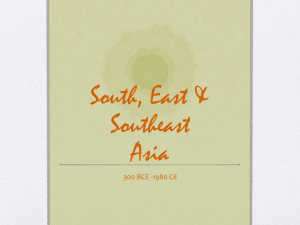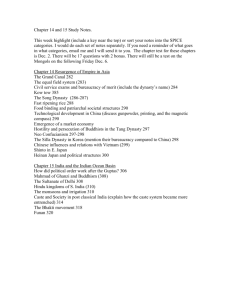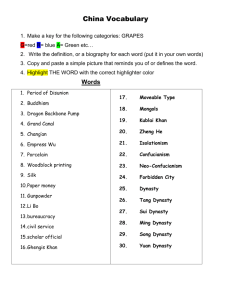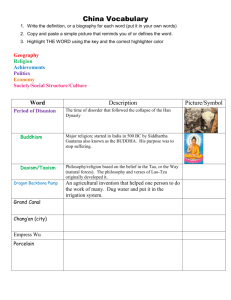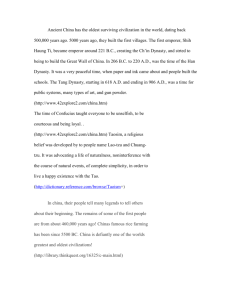Work Form Function Content Context Great Stupa at Sanchi Madhya
advertisement
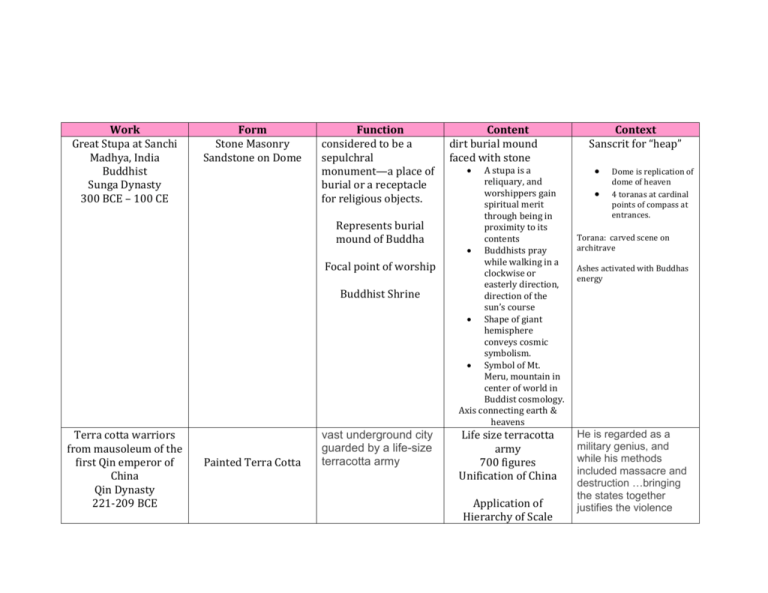
Work Great Stupa at Sanchi Madhya, India Buddhist Sunga Dynasty 300 BCE – 100 CE Form Stone Masonry Sandstone on Dome Function considered to be a sepulchral monument—a place of burial or a receptacle for religious objects. Represents burial mound of Buddha Focal point of worship Buddhist Shrine Terra cotta warriors from mausoleum of the first Qin emperor of China Qin Dynasty 221-209 BCE Painted Terra Cotta vast underground city guarded by a life-size terracotta army Content dirt burial mound faced with stone A stupa is a reliquary, and worshippers gain spiritual merit through being in proximity to its contents Buddhists pray while walking in a clockwise or easterly direction, direction of the sun’s course Shape of giant hemisphere conveys cosmic symbolism. Symbol of Mt. Meru, mountain in center of world in Buddist cosmology. Axis connecting earth & heavens Life size terracotta army 700 figures Unification of China Application of Hierarchy of Scale Context Sanscrit for “heap” Dome is replication of dome of heaven 4 toranas at cardinal points of compass at entrances. Torana: carved scene on architrave Ashes activated with Buddhas energy He is regarded as a military genius, and while his methods included massacre and destruction …bringing the states together justifies the violence “Mourning Scene” had some connection with the afterlife. Funeral banner of Lady Dai (Xin Zhui) Han Dynasty China 180 BCE Longmen Caves Luoyang, China Tang Dynasty 493-1127 CE Painted Silk Limestone “name banners” used to identify the dead during the mourning ceremonies, or they may have been burial shrouds intended to aid the soul in its passage to the afterlife Mainly carved for individuals, then state carvings began. Preserve Buddhism Affirm assimilation & superiority Artists made efforts to indicate depth through early example of pictorial (representing the use of the naturalistic scenes not overlapping bodies of the mourners. They just abstract shapes) art in China. Secondly, also made objects in the foreground larger, the banner features and objects in the the earliest known background smaller, portrait in Chinese to create the illusion of painting space in the mourning hall. Limestone cliffs extend for almost a mile and contain approximately 110,000 Buddhist stone statues 60 stupas Buddhism, born in India, was transmitted to China intermittently and haphazardly. Starting as early as the 1st century C.E., Buddhism brought to China new images, texts, ideas about life and death, and new opportunities to assert authority Gold & Jade crown Three Kingdoms Period Silla Kingdom, Korea 5th – 6th c CE Todai-Ji Nara, Japan Various Artists including sculptors Unkei & KeiKei & Kei School 743 CE, rebuilt c. 1700 Metalwork Crown, very lightweight, maybe used in ceremonial occasions, perhaps only for burial. Silla Kingdom was most powerful “Country of Gold” Bronze & Wood (sculpture) Wood w/ Ceramic-tile roofing (architecture) “Great eastern temple” unite various Japanese clans under his (Shomu) centralized rule, Shomu also promoted spiritual unity Nio Guardian Figures Antler forms influenced by shamanic practices in Siberia Symbolizes geometric trees. Uncovered in a royal tomb Emphasize power of wearer “Spiritual rank” Largest temple at the time built on Japanese soil. was the largest building project ever on Japanese soil. Its creation reflects the complex intermingling of Buddhism and politics in early Japan Japan’s most celebrated school of sculpture. It was Protect the buddha monument to the Buddha Borobudur Temple Central Java, Indonesia Sailendra Dynasty c. 750-842 BCE Volcanic-stone masonry Many levels of meaning, reflecting Buddhist cosmology Aligned w/4 points on compass “City Temple” Angkor, The temple of Angkor Wat, and the city of Angkor Thom Cambodia Hindu, Angkor Dynasty 800-1400 CE Lakshamana Temple Khajuraho, India Hindu Chandella dynasty 930-950 CE Stone Masonry, Sandstone Capital of medieval Cambodia Classic Khmer Architecture Sandstone Hindu Temple Vishnu – Main Deity Base has ornamental niches. built to impress. Twice overall plan is that of a three-dimensional mandala—a diagram of the cosmos used for meditation 3-Layers Pyramid Trunk of a Cone Stupa on Top carved bas reliefs at Angkor Wat, representing eight different Hindu stories Corbelled roofs Horror Vacui of sculptural reliefs Series of shapes that build to become a large tower. Torans- stone garland above entrances basic structure resembles that of a pyramid, yet it has been also referred to as a caitya (shrine), a stupa (reliquary), and a sacred mountain. In fact, the name Śailendra literally means “Lord of the Mountain.” largest religious monument in the world dedicated to the Hindu god Vishnu intended to serve as the king’s mausoleum in death. Sculptures have harmonious integration with architecture Court Scenes & erotica/sexual motifs. Travelers among the Mountains and Streams Fan Kuan c. 1000 CE Ink & colors On silk outstanding example of Chinese landscape painting expressed a cosmic vision of man’s harmonious existence in a vast but orderly universe primarily in the service of religion Shiva as Lord of Dance (Nataraja) Hindu, India Chola Dynasty c. 11th Century CE Night Attack on the Sanjo Palace Kamakura Period Japan c. 1250 – 1300 CE Cast Bronze Handscroll Ink & color on paper Shiva – most powerful god/destroyer composition is expressed through the skillful use of scale Search for truth in nature Thick/Thin lines for shading Round face, almond eyes, long arms. Circle of fire Expressive qualities of stone temple carvings with rich iconography possible in bronze casting. Civil war depiction Narrative read right to left, as scroll is unrolled Samurai Battle in Kyoto Chinese viewed mountains as sacred and imagined them as the abode of immortals. The term for landscape painting (shanshui hua) in Chinese is translated as “mountain water painting.” sacred object that has been taken out of its original context was intended to be movable Flame of destruction annihilates all sound Standing on demon of ignorance As scroll unrolls, time advances Coup where emperor is taken prisoner The David Vases Yuan Dynasty, China 1351 CE Portrait of Sin Sukju (1417-1475) imperial bureau of painting c. 15th century CE Korea Forbidden City Beijing China Ming Dynasty 15th century CE & later White Porcelain w Cobalt-blue underglaze Hanging Scroll Ink & color on silk Offering for a general who had been made a god made for the altar of a Daoist temple and their importance lies in the dated inscriptions on one side of their necks, above the bands of dragons commemorated the sitter in both life and death High value materials Forbidden City was home to 24 emperors, Stone, masonry, marble, brick, wood, ad their families and servants during the ceramic tile Ming and the Qing dynasties. Solidify emperors power White Porcelain w Cobalt-blue underglaze Named after person who purchased them most important Dragon & floral pattern examples of blue-andwhite porcelain in existence, and are probably the bestknown porcelain vases in the world shows Sin Sukju dressed in his official robes with a black silk hat on his head Political propaganda large precinct of red walls and yellow (symbolic of royal family) glazed roof tiles located in the heart of China’s capital, Beijing official honored for his distinguished service at court and loyalty to the king Korean Portrait Conventions: seated in a full-length view, often with their heads turned slightly and only one ear showing. Crisp, angular lines composed of more than 90 palace compounds including 98 buildings and surrounded by a moat as wide as 52 meters. Ryoan-ji Kyoto, Japan Muromachi Period c. 1480 CE Rock Garden Raked Sand Jahangir Preferring a Sufi Shaikh to Kings Bichitr 1620 CE Watercolor, gold, and ink on paper Taj Mahal Agra, Uttar Pradesh, India 1632-1653 CE Supervision of Ustad Ahmad Lahori, architect of Emperor Stone Masonry & Marble Inlay of precious & semiprecious stones Gardens Garden as a microcosm of nature. Zen Dry garden Zen Wet Garden Sufi – Islamic mystic Jahangir favors a holy man over kings suitable, permanent resting place for his beloved wife Grand Palace displaying symmetry Rocks/ Water Peace of mind flames of gold radiate from the Emperor’s head against a background of a larger, darker gold disc. A slim crescent moon hugs most of the disc’s border, creating a harmonious fusion between the sun and the moon (thus, day and night), and symbolizing the ruler’s emperorship and divine truth. marble structure is topped by a bulbous dome and surrounded by four minarets of equal height. Gravel acts as water, rocks are mountain ranges. Seen as islands floating in a sea Meditative focus Sought to bring together things from distant lands Showing holy men placed above and ranking higher than all others exceptional for its monumental scale, stunning gardens, lavish ornamentation, and its overt use of white marble. White and Red Plum Blossoms Ogata Korin c. 1710-1716 CE Under the Wave off Kanagawa (Kanagawa oki name ura), also known as the Great Wave, from the series Thirty-Six Views of Mount Fuji Katsushika Hokusai 1830-1833 CE Painting Ink, watercolor & gold leaf on paper Polychrome Woodblock print Ink and color on paper Stream cuts rhythmically through the scene Concentration of a few details Deeply personal view of nature Emphasis on fragile, tender, and gentle nature rather than awesome, threatening or overwhelming Organized into patterned compositions most iconic work of Japanese art. polychrome (multicolored) woodblock print, made of ink and color on paper Ukiyo-e, which originated as a Buddhist term, means "floating world" and refers to the impermanence of the world Tarashikomi technique in which paint is applied to a surface that has not already dried from a previous application, creates dripping effect useful for depicting flowers or streams Rhythmic composition Painted on a screen View is limited to a few details that are carefully painted Hokusai’s print displays the influence of Dutch art, and proved to be inspirational for many artists working in Europe later in the nineteenth century Ukiyo-e prints are recognizable for their emphasis on line and pure, bright color, as well as their ability to distill form down to the minimum Chairman Mao en route to Anyuan Artist unknown Based on painting by Liu Chunhua 1969 CE Color Lithograph portray Chairman Mao as a revolutionary leader committed to championing the common people Idealized – appears superhuman Propaganda Striding atop a mountain peak wearing a look of determination on his face he would lead the country through a decade of violent class struggles aimed at purging traditional customs and capitalism from Chinese society. Founding father of China
